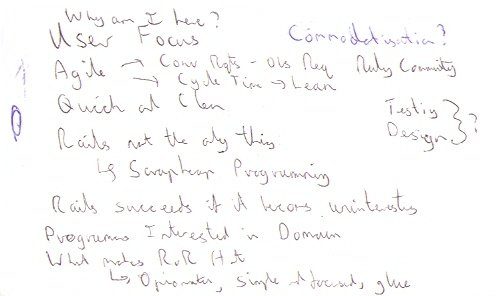Extemporary Speaking
18 August 2006
A while ago Jon Udell characterized two modes of public speaking:
- Scripted: where you write out pretty much exactly what you are going to say and either read or memorize it.
- Slide-driven: where you produce detailed slides and use them to drive what you say.
Most of my public talks these days use a third mode - extemporary speaking. In this style I begin with little more than a rough outline of my talk, and compose everything else as I go.
I've never done scripted talks, but did slide-driven for a long time. Partly I got sick of boring bullet slides, which were mostly there to remind me what to say, but mostly I got tired of being tethered to the slides. With a slide-driven talk you have to decide in advance most of what you are going to say - months in advance for many conferences. If you don't have slides nobody complains about you not following your slides, so I'm free to decide exactly what to talk about close to the talk itself.
A talk like this doesn't imply no preparation. You have to have good stuff to talk about and it has to be firmly embedded in your mind. I've spent my whole life preparing for my ad-hoc talks.
Rather more concretely, I do like to have an outline planned out in advance. I usually sketch a rough outline on an index card. That way I have a rough structure to follow.

The index card I used for my talk at RailsConf. (please send any remarks about my handwriting to /dev/null, I have to put up with it all the time.)
One tip that's been useful to me was one that someone else told me came from Tony Benn. Essentially this says to cover three main points in your talk, and let each main point have three main sub-points. I've often found this to be a useful starting point for the structure of a talk.
This style works well for keynote-style talks, which is what I'm most often asked to do these days. When I do give a talk with some detailed technical content I do use slides for code samples or diagrams. I've always used very few slides, however, so they don't give much more than an outline - but that is then fixed in advance.
With an extemporary talk I can decide on the exact content as late as a few minutes before the talk. If I'm at a conference I like to get a sense of the what's going on and what the overall conversation is before I choose my topics. Of course with such a rough structure there's still a lot of room for deciding exactly what I'm going to say - and all that is done only when I'm actually speaking.
One danger with this approach is being quoted. When I write I can think carefully about what I'm writing to express it in as clear a way as I can. With extemporary speaking there is a big danger of saying something that isn't really what you mean. In a limited audience that's no big deal, but it can be a real issue if it's broadcasted all over the Internet. This is a major reason why public figures don't like to be extemporary, which I think is a big shame.
This is not a style for everyone. Some people are more comfortable and able to do this kind of thing than others, and I'm lucky taht this kind of thing has always been one of my skills. I like it because I think it brings over a greater spontaneity and energy. I think it also contrasts nicely with the very polished scripted talks we are used to seeing in the media, let alone the mass of PowerPoint we usually see at technical conferences.

